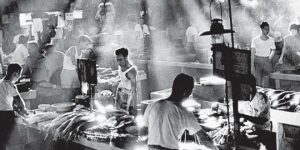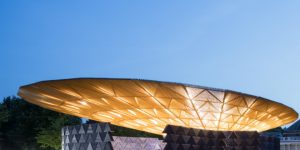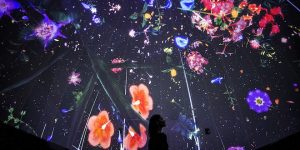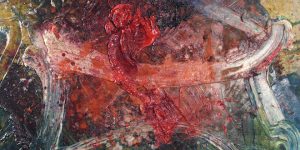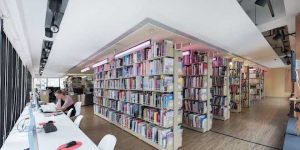Venice Biennale 2017: Southeast Asia represented by pavilions from Singapore, Indonesia and more
Southeast Asia scores both hits and misses at the 57th Venice Biennale — one more so than the other

Lani Maestro and Manuel Ocampo, ‘The Spectre of Comparison’, 2017. Image courtesy La Biennale di Venezia
Viva Arte Viva!
Such is the passionate outcry of Christine Macel, the director and curator of the 57th edition of the Venice Biennale. In her words: it’s a passionate cry for the art and the state of the artists. A remarkable feat of her curated exhibition of 120 artists is the way it reveals highlights of craft and textiles, making the atmosphere in the Arsenale show even warmer and more intimate.
Although a national pavilion need not follow the line of the main exhibition, the Singapore Pavilion seems to perfectly fit Macel’s vision in its selection of the whimsical and charismatic Jailani Zai Kuning (b. 1964) to represent its national pavilion with his work ‘Dapunta Hyang, Transmission of Knowledge’. Apart from being awe-inspiring, this sculptural representation of a fantastic 17-metre-long rattan ship testifies to creative thought regarding the past and present. Reviving the historic power of the Srivijaya Kingdom and the orang laut of the Riau archipelago, Zai makes it clear that it encompassed the entire region, not only Singapore.

Zai Kuning, ‘Dapunta Hyang: Transmission of Knowledge’, 2017. Image courtesy National Arts Council
The gigantic vessel made of beeswax and string also seems to imply another way of seeing. Using the ancient technique of ship building reveals it as being on par with modern ship building. After all, as Zai Kuning emphasised, “we are not slaves”.
The travels of the first Malay Maharaja Dapunta Hyang Sri Jayanasa through the kingdom of Srivijaya which was based in Sumatra and whose power extended to parts of what is now known as Southeast Asia — including Singapore, Indonesia, Malaysia, Thailand, and Vietnam — also shows how closely related the peoples of this region were, traditionally and culturally. Meanwhile, his depiction of mak yong opera, a pre-Islamic art form found in Indonesia that traditionally includes singing, acting, rituals, and dance, opens up ways to shape new, contemporary forms of art and culture.
In contrast to the Singapore Pavilion, however, the other Southeast Asian pavilions were far less impressive. For the Indonesia Pavilion, curated by Agung Hujatnikajennong and Enin Supriyanto, artist Tintin Wulia (b. 1972) conceptualised three interconnected works under the umbrella title ‘1001 Martian Homes’. The idea was to show the future in the present, letting exiles of atrocities on earth tell their stories on Mars, 200 years later, suggesting a borderless world through digital technology and cameras. However, this ambitious concept could not be fully realised, both artistically and production-wise. An unimpressive flickering display of LED lights and eyeballs appearing along a staircase in the 70-square-metre space came across as cheap and kitschy, while a video featuring exiles telling their stories from their homes on Mars was uninspiring. Connecting the pavilion to a twin version in the Jakarta Senayan City Shopping Mall did not particularly enhance it either.

Tintin Wulia, ‘1001 Martian Homes’, 2017. Image courtesy La Biennale di Venezia
The Pavilion of the Philippines, curated by MCAD Director/Curator Joselina Cruz and artists Lani Maestro and Manuel Ocampo, both of whom had previously lived abroad, attempted to compare their works with their experiences in Europe. The pavilion’s title comes from the national novel of the Philippines, José Rizal’s Noli Me Tángere. In the book, Rizal’s protagonist Crisostomo Ibarra sees the gardens of Europe when gazing out into the botanical gardens of Manila. Presumably, this work is based on that comparative gaze between the two countries.
The curator’s description of the work: “The exhibition looks at their practices as emblematic of the experience of Rizal‘s specter of comparisons, the juxtaposition of their works, the manifestation of political and social commentary from afar, as they saw the events of the Philippines and their adopted countries through an inverted telescope”. An interesting idea, which, however, was not made clear in the exhibition, where Lani Maestro’s neon texts on body and pain hung without context or comparison with Ocampo’s paintings. Perhaps the benches set in the center of the venue were meant for visitors to sit and ponder the inexplicability of the phenomenon.

Lani Maestro and Manuel Ocampo, ‘The Spectre of Comparison’, 2017. Image courtesy La Biennale di Venezia
The Thai Pavilion in the Paradiso Gallery Café located in the Giardini also failed to show its worth. Curated by gallery owner Numthong Sae Tang, the artist Somboon Hormientong may have intended to show the appeal of Bangkok’s daily life. But what visitors got to see was somewhat less appealing: silver alms bowls in a glass cabinet, stacks of plastic baskets, chairs and buckets that would not have looked out of place in the marketplace, and a Buddha statue in an old wooden box. Even the video about Bangkok neighbourhoods was unable to engage. All in all, the show behind a flourishing Café Paradiso seemed to have lacked preparation.
It is saddening to see how the Philippine Pavilion has slid back after its great comeback in 2015. Similarly, it is worrisome that the strong showing of the Indonesia Pavilion in 2013 and 2015 is now evidently suffering from severe anemia.
This article was written by Carla Bianpoen for Art Republik.




